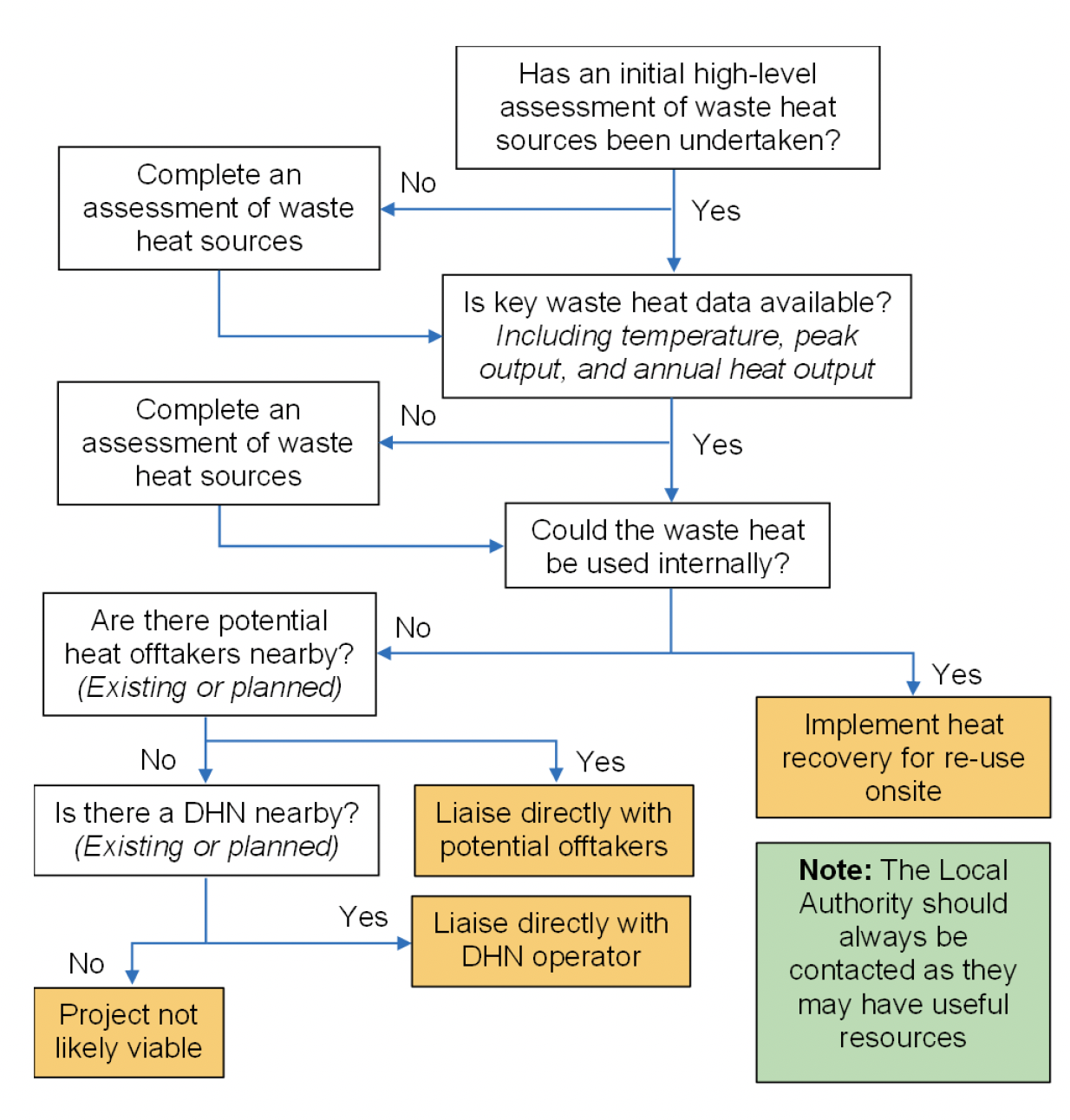Waste heat recovery: introductory guide
Information about waste heat recovery and its potential as a low carbon heat source, as well as the process of capturing and utilising heat from industrial and commercial processes. The recovered heat can be used in a range of applications including heat networks.
5. Next steps
5.1 Project decision tree
As with any construction project, preparation is needed for a waste heat project. Given the potentially large investment of time and money, it is important to diligently assess whether to proceed with the project. An example project decision tree is shown below:

5.3 Assessing feasibility
- Initial assessment
An investigation that covers the fundamental questions of:
A. Looking at plant operations, is there available waste heat?
B. What is a high-level estimate of the amount and grade of heat available?
- Data collection
A list of key data to gather, and methods of how to gather or estimate it, is shown in Table 6 below.
| Data | Description | How to gather it? |
|---|---|---|
| Peak waste heat supply | The maximum amount of heat that can be supplied over a timeframe (e.g. one hour). | Preferably derived from metered data taken directly at the waste heat recovery point. Alternatively: estimate based on similar case studies. |
| Annual waste heat supply | The amount of heat that can be supplied over the course of a year, in normal operations. | As above. Note that this should account for the usual number of disruptions (e.g. planned/unplanned outages). |
| Plant/ infrastructure capital costs | The initial purchase costs for all heat recovery and enabling equipment. | Ideally: gathered from equipment manufacturers. Alternatively: estimate using industry benchmarks based on peak heat supply. |
| Installation costs | The installation costs for all heat recovery and enabling equipment. | Ideally: Gathered from equipment manufacturers. Alternatively: Estimate using industry benchmarks based on peak heat supply. |
| Operational costs | Costs for operating and maintaining the equipment and systems | Estimated using input from maintenance providers, manufacturers and through using benchmarks from similar schemes |
| Fuel savings | The amount of fuel savings from reusing captured waste heat. | Calculated by comparing annual heat demand for a process and the annual waste heat supply. |
| Carbon emission savings | The carbon emissions saved from reusing waste heat or selling it to consumer. | Applying a carbon emission factor to the displaced fuel (either from selling to a consumer or using in a process). |
| Funding mechanisms | Potential additional project funding. | Research the funds that are available for the specific project. |
| Heat demand | The amount of heat an offtaker requires over the course of a year. | As above. Engagement with offtakers is very important for this. Uncertainty or unpredictability on heat demand can hurt economic viability. |
| Income | The income from selling heat to an offtaker. | Applying a heat tariff to the estimated waste heat that can be sold to offtakers. |
5.4 Stages of project works
Waste heat projects are construction projects which should follow standard project models. The two most popular frameworks that concern waste heat recovery projects are:
- Royal Institute of Building Architects (RIBA) Stages
- Code of Practice - 1 (CP1)
Both frameworks have similar stages that guide a project from inception to completion and eventual handover. There are overlaps, but the key difference is RIBA stages are more general to any construction project, whilst CP1 only applies to district heat networks. The diagram below details the links between the two and shows key project milestones for each stage.

5.5 Additional resources
The following resources can provide further information:
- Scotland Heat Map: a map of estimated heat demand for domestic and non-domestic buildings in Scotland. This resource can be useful to identify potential offtakers, consumers and nearby waste heat providers. Most data is available to the public sector but more detailed information is available from the relevant local authority, subject to data sharing agreement.
Scottish Government Website - Heatmap
- Local Authority: each Scottish Local Authority should already have, or be in the process of completing, their Local Heat and Energy Efficiency Strategy (LHEES). Each Local Authority should have a dedicated LHEES Officer (or similar) who can help give a local view of waste heat sources, possible demand, and plans for local Heat Network Zones.
- Heat Network Support Unit (HNSU): a Scottish focussed collaboration of organisations that provides funding, information and further signposting to support DHNs in Scotland.
Heat Network Support Unit Website
- Association for Decentralised Energy: is a trade association supporting the growth of decentralised energy in the UK, with over 130 members. The group advocates for members through engagement with government and key decision makers on issues ranging from policy to industry standards.
The Association for Decentralised Energy Website
- Danish Board of District Heating (DBDH): is an organisation representing the leading members of the Danish district energy sector. DBDH organise conferences, seminars, and exhibitions to foster global knowledge sharing.
Danish Board of District Heating Website
- Handbook for Increased Recovery of Urban Excess Heat: consolidates information from low temperature waste heat recovery demonstration sites. It explores technical components, European urban waste heat potential, key stakeholders, and different business aspects.
Euroheat Website - Handbook for Increased Recovery of Urban Excess Heat
Contact
Email: heatnetworks@gov.scot
There is a problem
Thanks for your feedback